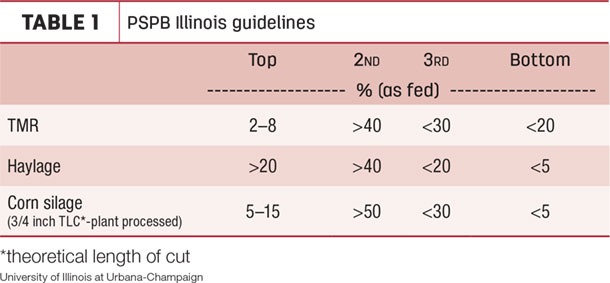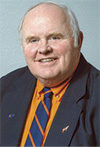What are the risks and rewards of changing the length of forage particles?
Defining fiber
Defining NDF (neutral detergent fiber) continues to be important in dairy rations. Dairy cows need two fiber sources: chemical fiber (which can be tested in forage testing labs) and physical fiber (causes cud chewing and affects rate of feed passage). The following NDF terms must be understood, as it influences dairy rations.
- aNFDom (amylase and ash-corrected) is the newest term reflecting the chemical NDF measured in a feed ingredient that has starch removed (treated with an enzyme – amylase, leading to the letter “a”) and ash removed (“om” represents organic matter that drives rumen fermentation).
- NFD-D represents the percent of NDF fermented in the rumen, leading to higher feed intake and milk yield. This value can be measured in forage testing labs.
- uNDF (undigested NDF) is the percent of NDF fiber that is not digested and impacts dry matter intake (DMI). This value can also be measured in forage testing labs.
- NDF-Forage represents the percent of NDF from traditional forage sources (such as silages and hay) with no adjustment for particle size. Byproduct feed ingredients such as fuzzy cottonseed, soyhulls and citrus pulps would not be included unless the user decides to code these as a forage in the ration-balancing program.
- NDF rate of passage reflects the speed at which NDF clears the digestive tract as a percent per hour. If the rate is too fast, fiber digestibility can be reduced. If the rate is too slow, DMI can be reduced.
Length of fiber
The focus is: How long or short should silage and hay be chopped or processed to provide the optimal level of physical fiber? If the forage fiber is too short, the fermentation can be negatively impacted, leading to lower digestibility, rumen acidosis and higher rate of feed passage. Manure scores below 3 may reflect that a problem has occurred. If the forage is too long, DMI may be reduced and sorting for or against the longer particles can happen.
One common field-based tool is the Penn State Particle Box (PSPB) that allows the user to separate various feed particles based on their length. Table 1 provides guidelines for silages and TMR using the four-box unit.

All percentages are based on weighing each box on an as-fed basis or wet basis.
Wet feed ingredients, such as wet brewers grain and corn silage, contain water, which is weighed resulting in an error. If you use the three-box PSPB, add the bottom two values together. The main change has been reducing the amount in the top box from 2 to 8 percent. Lowering the top box percentage can reduce sorting. (No forage particles over 1 to 1.5 inches should appear in the top box.)
Researchers report cows reduce long forage particles down to 10 mm (approximately 0.5 inch) before swallowing in the feed bolus. With fewer particles on the top box (the top box holes are 0.75 inch or 18 millimeters diameter), cows may be able to consume feed faster and need less time at the feedbunk to meet their DMI. Shorter particles in the TMR could be a factor with overcrowded feedbunks. However, less chewing time means less saliva production containing sodium bicarbonate to buffer the rumen pH. Some nutritionists recommend no feed particles appearing in the top box.
A key value in the PSPB is the second box (with holes 0.3 inch or 7 millimeters), which should be over 45 percent with the top box and the second box containing over 50 percent.
Take-home message: Recognize that forage particles can be too long or too short. Measure each forage for particle size and your TMR sample, making adjustments for optimal ensiling, packing and animal intake and health. Increasing TMR mixing and processing time and pre-processing forages can achieve desired ration particle size.
Relationship: Forage particle size and forage quality
Researchers at Miner Institute, Chazy, New York, reported interesting results when combining forage quality and forage particle size. If forage quality is excellent, forage particles should be longer to maintain forage digestibility. If forage quality is low, process the forage particles shorter to improve intake and rate of passage.
The research team also tested high- or low-quality forage with short or long forage particle size. The best combination was high-quality forage processed longer and low-quality forage processed shorter. (Both groups had similar cow responses.) High-quality forage processed in shorter lengths and low-quality forage processed in longer lengths did not optimize dry matter intake, milk yield or rumen health.
Take-home message: Adjusting particle size to complement forage quality can optimize rumen health and DMI. No “one right answer” works for all herds.
Forage fragility
Forage fragility reflects the stiffness or “scratch factor” provided by forages. For example, take the top PSPB forage, ball it up in your hand, and squeeze it. If it feels soft and pliable (such as BMR corn silage or lush grass forage), these forage particles may not stimulate rumen function. If forage particles stick to your hand or feel “prickly” (such as processed straw or low-quality hay), this forage could have a high fragility value, leading to lower feed intake and less milk.
Take-home message: All long feed particles do not function in the same way in the rumen and digestive tract. Dairy farmers may add 1 pound of straw to slow rate of passage, increase milkfat test and improve feed efficiency if the ration is too soft to stimulate cud chewing and rumination.
Processing straw and hay
Dry hay and straw forages can be pre-processed before adding to the TMR, thus reducing mixing time, and achieve a desired particle size before mixing the TMR. Straw pre-processing guidelines include one-third in the top box (no particles over 1 inch in this box), one-third in the middle box and one-third in the bottom box. One Midwest dairy farmer processes straw one day a week with a run time of 24 minutes to get the desired particle size in his vertical mixer and stores it as a commodity in one of his storage areas. Another Midwest dairy farmer discovered pre-processing his purchased high-quality Western-baled hay resulted in over 70 percent in the bottom box. The effective particle size of his hay was less than 30 percent. (It functioned as alfalfa leaf meal.)
Take-home message: Check your pre-processed forages to reduce sorting while maintaining effective particle length.
Compact TMR approach
While conducting a field training exercise in Denmark, we visited a Danish dairy farm with a compact TMR. Compact TMR is unique with all forages processed to 4 to 6 millimeters (less than 0.5 inch, with dry matter content between 30 to 40 percent dry matter). The wet and short TMR appeared as a coarse gruel or mix, which the cows could not sort as we watched them eat. When monitoring cows, only 30 percent were cud chewing at rest. Their milkfat test was optimal.
Take-home message: Limited research has been reported on this feeding system; monitor dry matter intake, milk components, feed efficiency, manure scores and cow responses. ![]()

-
Michael Hutjens
- Professor of Animal Sciences Emeritus
- University of Illinois – Urbana
- Email Michael Hutjens







